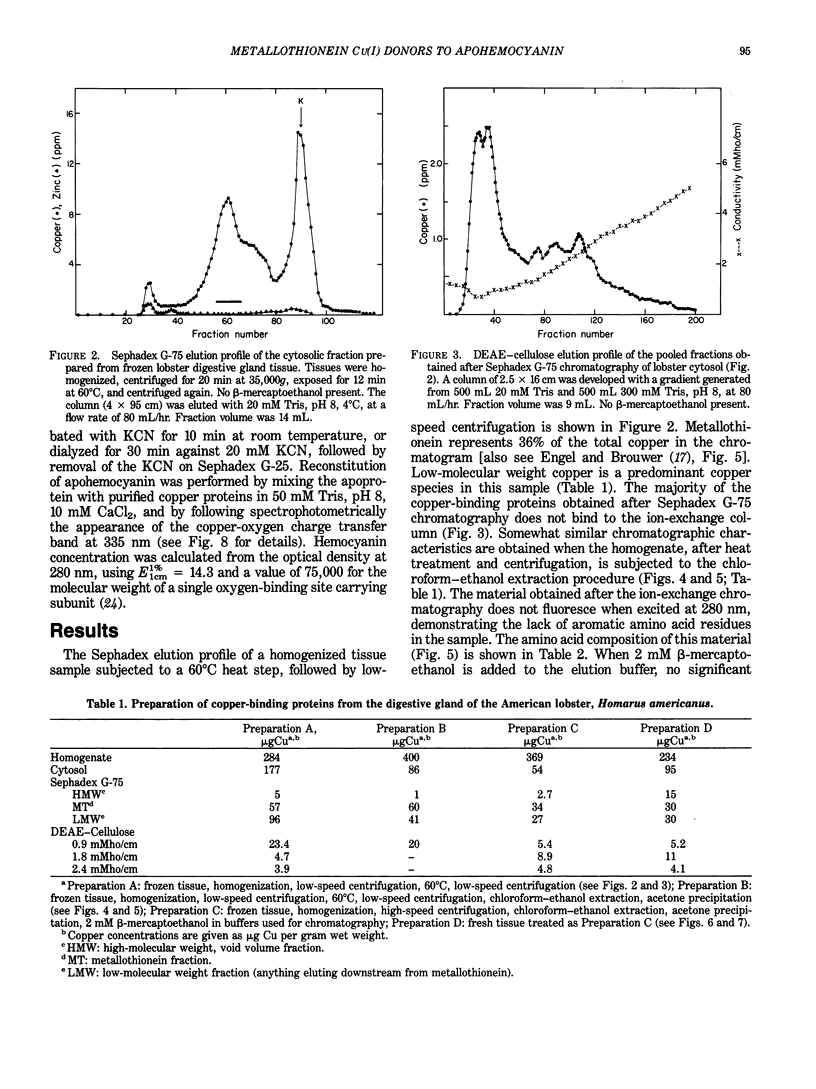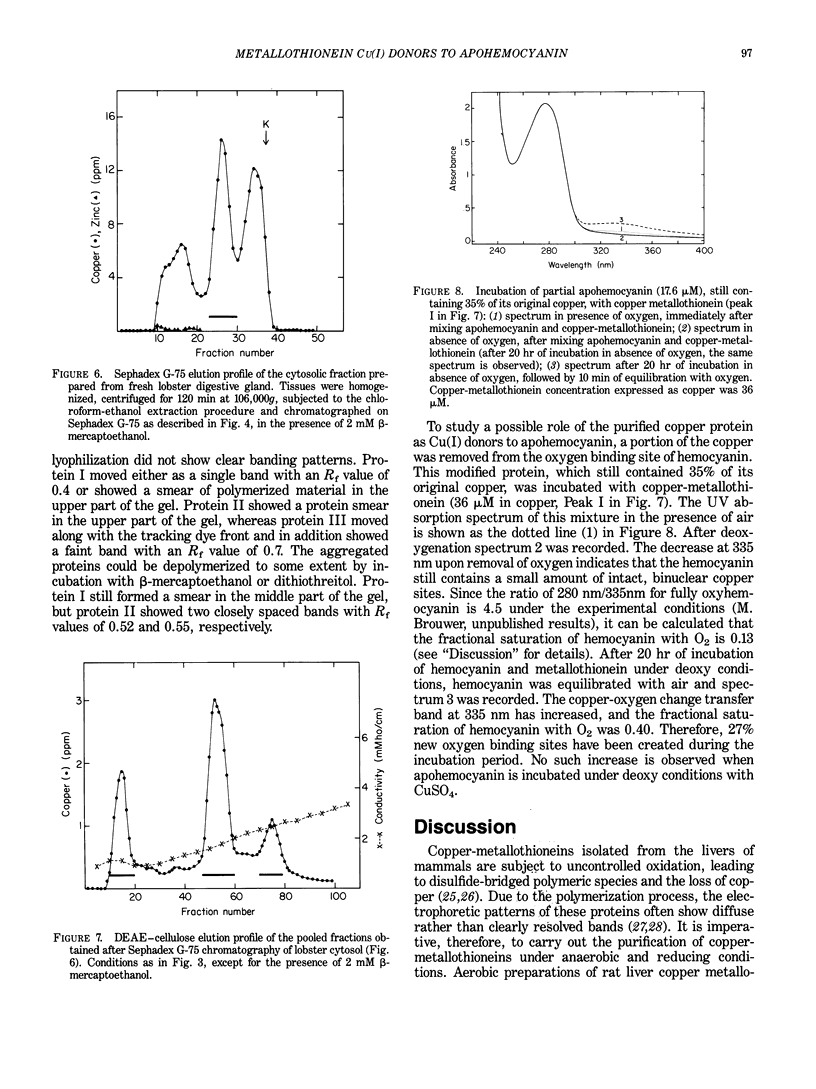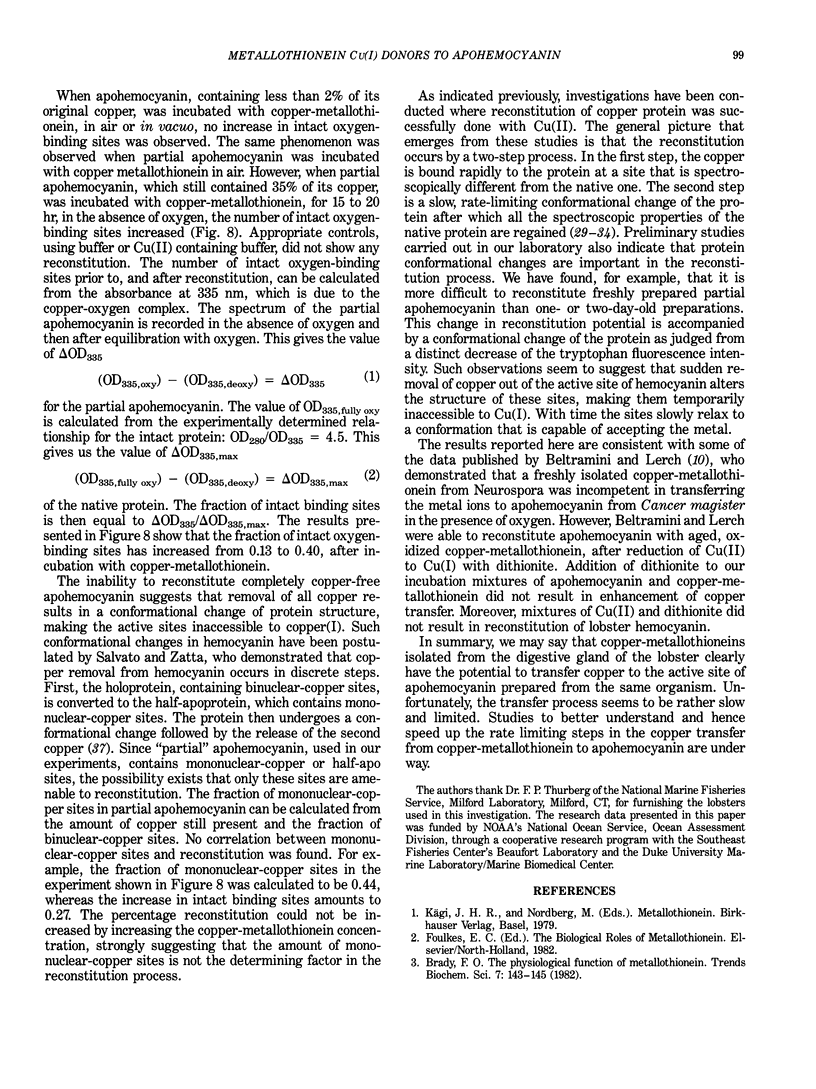Abstract
The physiological function of copper(I)-metallothionein is not well understood. The respiratory function of hemocyanin, a copper(I)-containing respiratory protein found in the hemolymph of many invertebrates, has been known a long time. However, the mechanism by which Cu(I) is inserted into the oxygen-binding site of apohemocyanin is completely unknown. This investigation tests the hypothesis that copper(I)-metallothionein may act as a Cu(I) donor to apohemocyanin. To this end, copper-binding proteins and hemocyanin were purified from the digestive gland and hemolymph of the American lobster, Homarus americanus. In the presence of beta-mercaptoethanol, the copper-binding proteins can be resolved into three components on DEAE-cellulose. The first two have been characterized as metallothioneins, based on their high cysteine content and lack of aromatic amino acid residues. The cysteine content of the third component is half of that of components I and II. In the absence of beta-mercaptoethanol the three proteins elute as a single protein complex during ion-exchange chromatography. Components I and II show a strong tendency to polymerize, a process that is accompanied by the loss of protein-bound copper. The purified proteins are not capable of transferring Cu(I) to the active sites of completely copper-free apohemocyanin. They are capable, however, of transferring Cu(I) to active sites of hemocyanin containing reduced amounts of Cu(I), suggesting that the conformational state of hemocyanin is the determining factor in the Cu(I) transfer mechanism.
Full text
PDF







Selected References
These references are in PubMed. This may not be the complete list of references from this article.
- Beltramini M., Lerch K. Copper transfer between Neurospora copper metallothionein and type 3 copper apoproteins. FEBS Lett. 1982 Jun 7;142(2):219–222. doi: 10.1016/0014-5793(82)80138-5. [DOI] [PubMed] [Google Scholar]
- Blaszak J. A., McMillin D. R., Thornton A. T., Tennent D. L. Kinetics of copper(II) uptake by apoazurin in complexing media. J Biol Chem. 1983 Aug 25;258(16):9886–9892. [PubMed] [Google Scholar]
- Brady F. O., Webb M. Metabolism of zinc and copper in the neonate. (Zinc, copper)-thionein in the developing rat kidney and testis. J Biol Chem. 1981 Apr 25;256(8):3931–3935. [PubMed] [Google Scholar]
- Bremner I., Young B. W. Isolation of (copper, zinc-) thioneins from pig liver. Biochem J. 1976 Jun 1;155(3):631–635. doi: 10.1042/bj1550631. [DOI] [PMC free article] [PubMed] [Google Scholar]
- Engel D. W., Brouwer M. Cadmium and copper metallothioneins in the American lobster, Homarus americanus. Environ Health Perspect. 1986 Mar;65:87–92. doi: 10.1289/ehp.866587. [DOI] [PMC free article] [PubMed] [Google Scholar]
- Geller B. L., Winge D. R. Metal binding sites of rat liver Cu-thionein. Arch Biochem Biophys. 1982 Jan;213(1):109–117. doi: 10.1016/0003-9861(82)90445-3. [DOI] [PubMed] [Google Scholar]
- Hartmann H. J., Weser U. Copper-thionein from fetal bovine liver. Biochim Biophys Acta. 1977 Mar 28;491(1):211–222. doi: 10.1016/0005-2795(77)90057-5. [DOI] [PubMed] [Google Scholar]
- Holtzman N. A., Gaumnitz B. M. Studies on the rate of release and turnover of ceruloplasmin and apoceruloplasmin in rat plasma. J Biol Chem. 1970 May 10;245(9):2354–2358. [PubMed] [Google Scholar]
- Kertesz D., Rotilio G., Brunori M., Zito R., Antonini E. Kinetics of reconstitutioin of polyphenoloxidase from apoenzyme and copper. Biochem Biophys Res Commun. 1972 Dec 4;49(5):1208–1215. doi: 10.1016/0006-291x(72)90597-9. [DOI] [PubMed] [Google Scholar]
- Keyhani E., Keyhani J. Cytochrome c oxidase biosynthesis and assembly in Candida utilis yeast cells. Function of copper in the assembly of active cytochrome c oxidase. Arch Biochem Biophys. 1975 Apr;167(2):596–602. doi: 10.1016/0003-9861(75)90503-2. [DOI] [PubMed] [Google Scholar]
- Laemmli U. K. Cleavage of structural proteins during the assembly of the head of bacteriophage T4. Nature. 1970 Aug 15;227(5259):680–685. doi: 10.1038/227680a0. [DOI] [PubMed] [Google Scholar]
- Li T. Y., Kraker A. J., Shaw C. F., 3rd, Petering D. H. Ligand substitution reactions of metallothioneins with EDTA and apo-carbonic anhydrase. Proc Natl Acad Sci U S A. 1980 Nov;77(11):6334–6338. doi: 10.1073/pnas.77.11.6334. [DOI] [PMC free article] [PubMed] [Google Scholar]
- Marks R. H., Miller R. D. A kinetic study of the reconstitution of azurin from Cu(II) and the apoprotein. Arch Biochem Biophys. 1979 Jun;195(1):103–111. doi: 10.1016/0003-9861(79)90331-x. [DOI] [PubMed] [Google Scholar]
- Minkel D. T., Poulsen K., Wielgus S., Shaw C. F., 3rd, Petering D. H. On the sensitivity of metallothioneins to oxidation during isolation. Biochem J. 1980 Nov 1;191(2):475–485. doi: 10.1042/bj1910475. [DOI] [PMC free article] [PubMed] [Google Scholar]
- Morpurgo L., Finazzi-Agrò A., Rotilio G., Mondovì B. Studies of the metal sites of copper proteins. IV. Stellacyanin: preparation of apoprotein and involvement of sulfhydryl and tryptophan in the copper chromophore. Biochim Biophys Acta. 1972 Jul 21;271(2):292–299. doi: 10.1016/0005-2795(72)90203-6. [DOI] [PubMed] [Google Scholar]
- Nielson K. B., Winge D. R. Preferential binding of copper to the beta domain of metallothionein. J Biol Chem. 1984 Apr 25;259(8):4941–4946. [PubMed] [Google Scholar]
- Oh S. H., Deagen J. T., Whanger P. D., Weswig P. H. Biological function of metallothionein. V. Its induction in rats by various stresses. Am J Physiol. 1978 Mar;234(3):E282–E285. doi: 10.1152/ajpendo.1978.234.3.E282. [DOI] [PubMed] [Google Scholar]
- Ohtake H., Hasegawa K., Koga M. Zinc-binding protein in the livers of neonatal, normal and partially hepatectomized rats. Biochem J. 1978 Sep 15;174(3):999–1005. doi: 10.1042/bj1740999. [DOI] [PMC free article] [PubMed] [Google Scholar]
- Rigo A., Viglino P., Bonori M., Cocco D., Calabrese L., Rotilio G. The binding of copper ions to copper-free bovine superoxide dismutase. Kinetic aspects. Biochem J. 1978 Feb 1;169(2):277–280. doi: 10.1042/bj1690277. [DOI] [PMC free article] [PubMed] [Google Scholar]
- Rydén L., Deutsch H. F. Preparation and properties of the major copper-binding component in human fetal liver. Its identification as metallothionein. J Biol Chem. 1978 Jan 25;253(2):519–524. [PubMed] [Google Scholar]
- Udom A. O., Brady F. O. Reactivation in vitro of zinc-requiring apo-enzymes by rat liver zinc-thionein. Biochem J. 1980 May 1;187(2):329–335. doi: 10.1042/bj1870329. [DOI] [PMC free article] [PubMed] [Google Scholar]
- Winge D. R., Geller B. L., Garvey J. Isolation of copper thionein from rat liver. Arch Biochem Biophys. 1981 Apr 15;208(1):160–166. doi: 10.1016/0003-9861(81)90135-1. [DOI] [PubMed] [Google Scholar]


